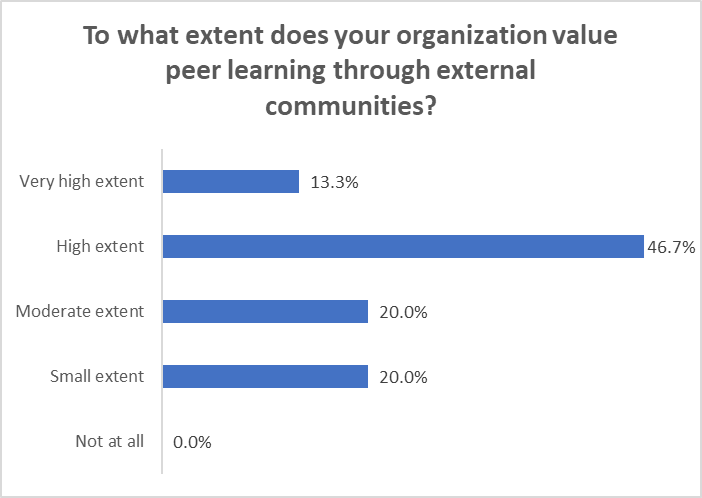ATD Blog
A Pathway for Tripling Productivity
Tue Nov 09 2021

Years ago, Lew Platt, a former CEO of HP once stated, “If only HP knew what HP knows, we would be three times more productive.” Recently, extensive buzz in the profession about knowledge sharing across boundaries via peer learning, collaborative problem solving, and other similar opportunities has been acknowledged. This seems to be more prevalent with the advent of intentionally integrating learning with the work and recent technology disruptions.
As a consortium based on the mantra Everyone a Learner, Everyone a Teacher, with a focus on peer-to-peer learning and collaboration, the ATD Forum was curious to find out how our members define, operationalize, promote, and measure the opportunities associated with knowledge sharing to advance performance and enhance engagement both virtually and in person. We used a quick survey to dig deeper.
The results indicated 95 percent of the respondents have some sort of process in place for internal knowledge sharing. While this practice is prevalent, it can look different in every organization. Like many aspects of learning, a similar technique might be called something different, or it might start off with one framework and over time morph into a different framework. Most common venues for this sharing are lunch & learns, Slack or Teams groups, course cohort groups, project teams, peer coaching, communities of practice, and action learning teams. Other venues include mastermind groups, hackathon teams, and groups for user-generated content such as learning or knowledge boards.
One interesting phenomenon is that peer can have different meanings. In some circles, it means employees with a similar rank, like midlevel managers. In other circles, it means all employees. Thus, this is the reason for putting peer learning and collaboration under a broader and more general topic of employee knowledge sharing.
The overarching goal for these groups is building performance capability within the organization, especially capability aligned with the work and the related functional domains. For example, there may be a group for the sales team, or the engineers, or the talent professionals. Regardless of the group configuration, according to the respondents, other benefits include:
Building connections between departments and geographies
Advancing networking
Promoting self-directed learning
Providing support for learning in the flow of work
Opportunities for recognition, especially if badging is involved
Help with advancing in the organization, possibly into other departments or functional areas
According to the survey results, most of these groups are informal, and only a few of them are moderated or curated by a designated person. If it does happen, the moderating and or curation is done by one of the group members or the L&D team. Tracking of the employee learning is required by less than half of the respondent companies. This is done using the LMS, especially through the xAPI or via the performance review process. Other ways for tracking and documenting the learning experiences include detailing in a portfolio, using a badging system, and capturing in a development plan. Documentation by the participate is done primarily when the peer knowledge sharing and learning group is part of a formal course, such as a follow-up cohort group designed to facilitate practice skills and behaviors.
Besides internal employee sharing, 45 percent of the responding organizations had processes in place for employees to share with external sources. This sharing is done through professional consortiums like the ATD Forum, vendor-owned groups, and pay-for-services opportunities like the Katahdin Group (formerly the Raffoni Group). This type of knowledge sharing between and among peers provides various opportunities typically unavailable with internal sharing. Some of these benefits include benchmarking processes, staying in front of trends and practices, sharing resources, and learning from others. These opportunities can save time and money, accelerate solving business challenges, and are highly valued. For groups like the ATD Forum, there are extensive leadership opportunities available like hosting an experiential lab, sharing case studies, co-facilitating interactive sessions with senior professionals from other companies, and even authoring blogs and book chapters.

According to the respondents, many benefits are associated with performance and engagement with employee knowledge groups, such as:
Extending the opportunities from formal learning sessions, especially for practicing skills
Promoting a continuous learning culture
Enhancing cross-functional awareness between departments, especially to gain acumen around how the business works
Building personal connections across the organization
Supporting self-directed learning
Providing a safe space to experiment and test new ideas especially from diverse perspectives
Promoting opportunities for lateral moves or advancement
The survey respondents provided excellent ideas for making any peer knowledge sharing venue more successful:
Have a common goal or purpose
Align the program with company goals and the business objectives then connecting measurement to those goals
Develop a loose, overarching strategy that allows for flexibility while providing the structure necessary to be successful
Include content and ideas that are germane to the needs of the organization with options for employees to curate content
Engage champions (for example, executive or senior sponsorship to ensure the group is seen as part of the corporate culture)
Tie participation and demonstration of learning needs to the annual performance accomplishments
Offer technical support to better enable access and contributions by a dispersed workforce
Advertise
Make it habitual and integrated with the broader learning ecosystem by embedding it in culture, tracking it, and reporting on it
While these groups are usually informal, some have guidelines. For more details on peer learning, please read this post from the Peer Learning Institute. For more details on communities of practice, a great resource is “Expand Employee Learning With Communities of Practice.” In Leading the Learning Function, Laura Solomon and Caroline Fernandes disseminate various peer sharing practices, especially detailing peer coaching used by IBM. John Parsell’s TD at Work article imparts ideas and tips for successfully executing a hackathon.
It is a known fact that much of the know-how in an organization, both the institutional knowledge and techniques for doing the tasks, is tacit. With time and resources at a premium and the constant need to upskill and reskill, dynamic and engaged knowledge sharing groups in organizations can be a game changer. Technology advancements have made it easier to connect and share across geographies and time zones. Learning in the flow of work is only possible when there are myriad ways for employees to access information.
Think about the Platt quote for tripling productivity in your organization. Consider the opportunities to learn from other organizations. How is your learning function promoting and supporting knowledge sharing? How can you enhance the process and thus build greater capacity for extending performance capability using some of these suggestions?
